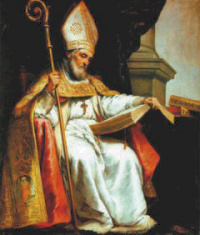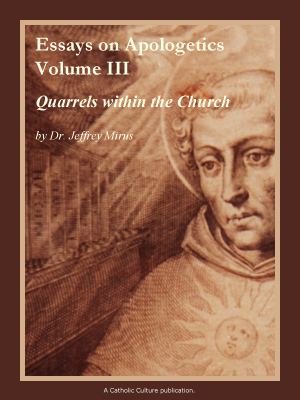Lent: April 4th
Friday of the Fourth Week of Lent; Opt. Mem. of Saint Isidore, Bishop and Doctor of the Church
Other Commemorations: St. Francisco Marto (RM)
» Enjoy our Liturgical Seasons series of e-books!
The hostility of the enemies of Jesus becomes increasingly clear, and the agitation around His person continues with greater intensity; but He awaits His "hour." Satan and the forces of evil will appear to triumph, but the real victory will come and that is God's. —St. Andrew Missal
The Church celebrates the Optional Memorial of St. Isidore of Seville (560-636), who succeeded his brother St. Leander as Archbishop of Seville. He was one of the great bishops of the seventh century. He was proficient in all branches of knowledge and was regarded as one of the most learned men of his time; with Cassiodorus and Boethius he was one of the thinkers whose writings were most studied in the Middle Ages. St. Isidore died in 636. Pope Innocent XIII canonized him in 1722 and proclaimed him a Doctor of the Church. He is the patron saint of the internet.
The Roman Martyrology commemorates St. Francisco (1908-1919), the boy visionary of Our Lady of Fatima. Our Lady appeared to three children, Lucia dos Santos, who was 10 years old, and her cousins Francisco Marto (9) and his sister Jacinta (7). They tended to their families’ sheep in the fields of Fatima, witnessed the apparitions of Mary, now commonly known as Our Lady of Fatima. Pope St. John Paul II beatified Francisco and Jacinta May 13, 2000, on the 83rd anniversary of the first apparition of Our Lady at Fatima. Both under 12 years old, they were the youngest non-martyrs to be beatified in the history of the Church. Francisco and Jacinta Marto were officially declared saints of the Catholic Church by Pope Francis on May 13, 2017, in Fatima, Portugal. St. Jacinta's commemoration is February 20. In some calendars, such as in Portugal, both Jacinta and Francisco are celebrated on February 20.
Meditation for Friday of the Fourth Week of Lent
As Jesus neared the end of His public life, the opposition of the Jewish leaders became more violent and their desire to kill Him more determined. Our Lord, however, continued to teach in the temple, where large crowds came to hear Him. The admiration of the people intensified the hatred of the priests, and they planned to ensnare Jesus in His speech that they might have grounds for condemnation. While His enemies plotted His downfall, Our Lord spent the night in prayer on the Mount of Olives.
The contrast between the character of Christ and that of His enemies could not be more pronounced. Yielding to base passion, they were openly seeking the death of the Messiah. Jesus, on the contrary, in the spirit of generous charity, was spending His days in teaching and His nights in prayer. Does our conduct in difficult circumstances resemble that of Christ? When we are unjustly accused, criticized, or condemned, do we calmly continue our work and have recourse to God in prayer? Perhaps we seek vengeance upon those who oppose us by wishing them evil or persuading others to despise and condemn them. Let us leave our reputation in the hands of God and imitate Christ's efforts to benefit those who hated and condemned Him.
"The Lord is the protector of my life: of whom shall I be afraid?"
—Excerpted from Liturgical Reflections, Sisters of St. Dominic
Highlights and Things to Do:
- If you wish to gain the courage to embrace the small crosses in your life with joy, pray the Stations of the Cross. This is an excellent practice that should not only be confined to Lent but ought to be prayed on Fridays throughout the year. An excellent version with beautiful meditations composed by Pope John Paul II is his Stations of the Cross at the Colosseum. Some recommended versions are: Eucharistic Stations of the Cross, and the more traditional Stations of the Cross written by Saint Alphonsus Liguori can be found in most Catholic bookstores. Here are some guidelines for praying the Stations of the Cross in your home.

Friday of the Fourth Week of Lent
Station with Sant'Eusebio all'Esquilino (St. Eusebius in Esquiline):
Today's Station Church is the ancient church dedicated to St. Eusebius of Vercelli, 4th century bishop. The church was financed by St. Eusebius of Bologna, and is first mentioned in 474. It is one of the oldest churches in Rome, being one of the first parish churches known as the Titulus Eusebi.
For more on Sant'Eusebio all'Esquilino, see:
For further information on the Station Churches, see The Stational Church.
St. Isidore of Seville
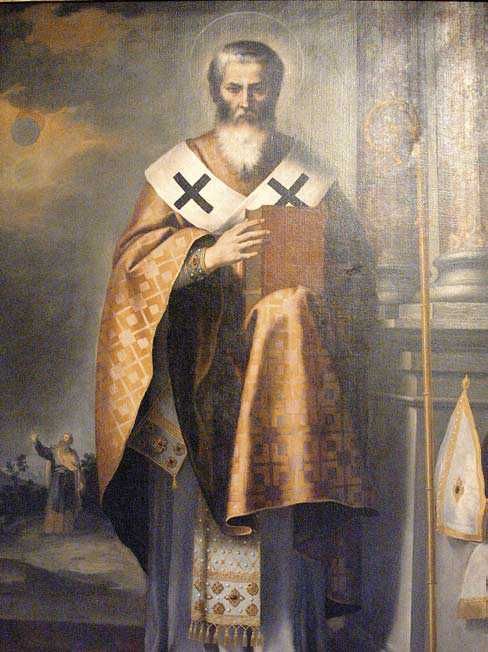 Saint Isidore, bishop of Seville and Doctor of the Church, had the phenomenal versatility of a Leonardo da Vinci. Like that famous Renaissance genius, he had an amazing store of information, including, among other things, a knowledge of history, science, natural history, literature, and philosophy.
Saint Isidore, bishop of Seville and Doctor of the Church, had the phenomenal versatility of a Leonardo da Vinci. Like that famous Renaissance genius, he had an amazing store of information, including, among other things, a knowledge of history, science, natural history, literature, and philosophy.
Isidore's parents gave four children to the Church: Leander, Fulgentius, and Isidore became bishops, Florentina became an abbess; all four were eventually canonized saints. Born about 560 at Cartagena, Spain, Isidore was educated by his elder brother, Archbishop Leander, in the cathedral school of Seville. He had always been a poor student until one day, when he was skipping school, he sat down near the edge of a spring and noticed some grooves worn into the rock. Discovering that the grooves were caused by the constant flow of water, he decided that, similarly, the continual repetition of lessons might make a permanent impression on his memory. After that, Isidore disciplined himself to long hours of study, and in a short time he mastered Latin, Hebrew, and Greek.
On March 13, 599, after Leander's death, Isidore succeeded to the see of Seville. The Visigoths (Germanic invaders) had controlled Spain for several centuries, and at that time their barbarous influence was threatening to destroy Spanish civilization. By using every educational and religious means at his disposal, Isidore converted the Visigoths from Arianism to Catholicism, thus unifying the faith of the nation. He also helped to eradicate the acephalite heresy (it professed that the human and divine natures in Christ are identical), encouraged monasticism, and strengthened religious discipline everywhere. Isidore guided the course of three synods and presided over the Fourth Council of Toledo, held in 633. There it was decided, under Isidore's influence, to establish a school in each diocese where the clergy could be trained in the liberal arts, and in Hebrew, Greek, medicine, and law.
Isidore was the first Christian writer to attempt compiling a summation of universal knowledge, an encyclopedia. His work, called Etymologies or Origins contained in compact form all the knowledge of his age. It preserved many fragments of classical learning in a way that was intelligible to the Germanic peoples of his time. This contribution to the field of education gained for Isidore the title "Schoolmaster of the Middle Ages," and until the middle of the sixteenth century his Origins remained a favorite textbook. He also rendered a great service to the Church in Spain by completing the Mozarabic missal and breviary begun by Saint Leander.
Isidore was as outstanding in the practice of charity and mortification as he was in the cultivation of knowledge. His house was continually crowded with the poor of the countryside. Shortly before he died, he went to church and, covering himself with sackcloth, had ashes placed on his head. Thus dressed as a penitent, he prayed earnestly for the forgiveness of his sins and gave all his possessions to the poor. He died a short time later, on April 4, 636.
—The Lives of the Saints for every day of the year, Vol. 1: January-April
Patronage: computer technicians; computer users; computers; the Internet; schoolchildren; students; Cartagena, Spain
Symbols and Representation: Bees; bishop holding a pen while surrounded by a swarm of bees; bishop standing near a beehive; old bishop with a prince at his feet; pen; priest or bishop with pen and book; with Saint Leander, Saint Fulgentius, and Saint Florentina; with his Etymologia.
Highlights and Things to Do:
- Listen to Catholic Culture's "Way of the Fathers" episode: 55—Isidore of Seville: Last of the Red-Hot Latin Fathers by Mike Aquilina.
- Read more about St. Isidore:
- For those who speak or read Latin and are fascinated by words you might take a look at The Etymologies.
- From the Catholic Culture library, Pope Benedict XVI's audience text: St. Isidore.
St. Francisco Marto
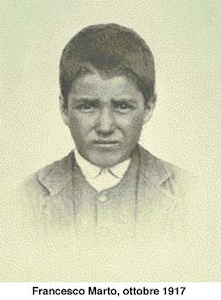 Between May 13 and October 13, 1917, three children, Portuguese shepherds from Aljustrel, received apparitions of Our Lady at Cova da Iria, near Fatima, a city 110 miles north of Lisbon. At that time, Europe was involved in an extremely bloody war. Portugal itself was in political turmoil, having overthrown its monarchy in 1910; the government disbanded religious organizations soon after.
Between May 13 and October 13, 1917, three children, Portuguese shepherds from Aljustrel, received apparitions of Our Lady at Cova da Iria, near Fatima, a city 110 miles north of Lisbon. At that time, Europe was involved in an extremely bloody war. Portugal itself was in political turmoil, having overthrown its monarchy in 1910; the government disbanded religious organizations soon after.
At the first appearance, Mary asked the children to return to that spot on the thirteenth of each month for the next six months. She also asked them to learn to read and write and to pray the rosary “to obtain peace for the world and the end of the war.” They were to pray for sinners and for the conversion of Russia, which had recently overthrown Czar Nicholas II and was soon to fall under communism. Up to 90,000 people gathered for Mary’s final apparition on October 13, 1917.
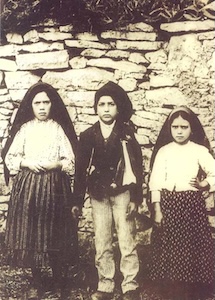
—Excerpted from Saint of the Day: Lives, Lessons and Feast by Leonard Foley, O.F.M.; revised by Pat McCloskey, O.F.M.
Highlights and Things to Do:
- Learn more about St. Francisco:
- Visit virtually the Shrine of Our Lady of Fatima in Fatima, Portugal.
- Read online Fatima in Lucia's Own Words.
- Catholic Cuisine for some food ideas for St. Francisco.


